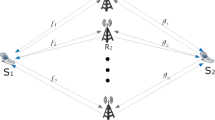Abstract
In multi-pair two-way relay networks, the control over inter-pair-interference is a challenging problem. When mobile stations (MSs) cooperate fully, to achieve the sum capacity of networks and at the same time completely remove the inter-pair-interference, a singular value decomposition (SVD) based beamforming scheme at relay station (RS) is established where SVD beamformers are applied over both uplink and downlink channels, respectively. To avoid any cooperation among users, an efficient beamforming scheme is proposed. This scheme uses the Max-SINR based receive beamformer at RS in uplink channel and the Max-SLNR based transmit precoder at RS in downlink channel. It omits interference (uplink) and leakage (donwlink) inside each pair of users due to their abilities of self-interference cancellation. This beamforming scheme provides an analytical solution like some well-known linear beamformers such as zero-forcing, block diagonalization, etc. From simulation, we find: the proposed SVD shows an excellent sum-rate performance at the expense of a large cooperation overhead at MSs and can be used as a tighter upper bound of sum-rate; the proposed scheme of Max-SINR beamformer plus Max-SLNR precoder performs much better on sum-rate than the ZF-based and the BD-based schemes by using almost the same computational amount.
Similar content being viewed by others
References
Fang Z, Hua Y, Koshy J C. Joint source and relay optimization for a non-regenerative MIMO relay. In: Proceedings of IEEE Workshop on Sensor Array and Multichannel Processing, Waltham, 2006. 12–14
Zhong B, Zhang Z S, Zhang X, et al. Impact of partial relay selection on the capacity of communications systems with outdated CSI and adaptive transmission techniques. EURASIP J Wirel Comm, 2013, 2013: 24
Cover T, Gamal A E. Capacity Theorems for the Relay Channel. IEEE Trans Inf Theory, 1979, 25: 572–584
Sendonaris A, Campbell Q, Erkip E, et al. User cooperation diversity. Part I: system description. IEEE Trans Commun, 2003, 51: 1927–1948
Kramer G, Gastpar M, Gupta P. Cooperative Strategies and Capacity Theorems for Relay Networks. IEEE Trans Inf Theory, 2005, 51: 3037–3063
Nosratinia A, Hunter T E, Hedayat A. Cooperative Communication in Wireless Networks. IEEE Commun Mag, 2004, 42: 74–80
Zhang Q C, Shu F, Wang M, et al. Relay selection schemes for precoded cooperative OFDM and their achievable diversity orders. IEEE Signal Process Lett, 2011, 18: 231–234
Yu X B, Zhou T T, Rui Y, et al. Cross-layer design for cooperative MIMO systems with relay selection and imperfect CSI. Sci China Inf Sci, 2013, 56: 49–58
Yu H, Qin H H, Li Y Z, et al. Energy-efficient power allocation for non-regenerative OFDM relay links outage probability analysis for superposition coded symmetric relaying. Sci China Inf Sci, 2013, 56: 185–192
Wu Y, Zheng M, Fei Z S, et al. Outage probability analysis for superposition coded symmetric relaying. Sci China Inf Sci, 2013, 56: 19–27
Rankov B, Wittneben A. Spectral efficient protocols for half duplex fading relay channels. IEEE J Sel Areas Commun, 2007, 25: 379–389
Knopp R. Two-way wireless communication via a relay station. In: GDRISIS meeting, Paris, 2007
Popovski P, Yomo H. Bi-directional amplification of throughput in a wireless multi-hop network. In: Proceedings of the IEEE VTC-Spring06, Melbourne, 2006. 588–593
Zhang R, Liang Y C, Chai C, et al. Optimal beamforming for two-way multi-antenna relay channel with analogue network coding. IEEE J Sel Areas Commun, 2009, 27: 699–712
Lee N, Hyun J Y. Achievable sum-rate maximizing AF relay beamforming scheme in two-way relay channels. In: IEEE ICC Workshops’08, Beijing, 2008. 19–23
Lee K J, Lee K W, Sung H. Sum-rate maximization for two-way MIMO amplify-and-forward relaying systems. In: the 69th IEEE Vehicular Technology Conference, Barcelona, 2009. 26–29
Xu S Y, Hua Y B. Optimal design of spatial source-and-relay matrices for a non-regenerative two-way MIMO relay system. IEEE Trans Wirel Commun, 2011, 10: 1645–1655
Li C G, Yang L X, Zhu W P. Two-way MIMO relay precoder design with channel state information. IEEE Trans Commun, 2010, 58: 3358–3363
Esli C, Wittneben A. One- and two-way decode-and-forward relaying for wireless multiuser MIMO networks. In: IEEE Global Communications Conference (IEEE Globecom 08), New Orleans, 2008. 1–6
Amah A U T, Klein A, Silva Y C B, et al. Multi-group multicast beamforming for multi-user two-way relaying. In: International ITG Workshop on Smart Antennas WSA, Berlin, 2009
Yilmaz E, Zakhour R, Gesbert D, et al. Multi-pair two-way relay channel with multiple antenna relay station. In: IEEE International Conference on Communications (ICC), Cape Town, 2010. 1–5
Degenhardt H, Klein A. Self-interference aware MIMO filter design for non-regenerative multi-pair two-way relaying. In: IEEE Wireless Communications and Networking Conference (WCNC), Paris, 2012. 272–276
Ma S D, Xing C W, Fan F, et al. Iterative transceiver design for MIMO AF relay networks with multiple sources. In: Proceedings of the IEEE MILCOM 2010, San Jose, 2010. 369–374
Liu Y, Tao M X. Optimal channel and relay assignment in OFDM-based multi-relay multi-pair two-way communication networks. IEEE Trans Commun, 2012, 60: 317–321
Hassibi B, Sezgin A, Khajehnejad M A, et al. Approximate capacity region of the two-pair bidirectional Gaussian relay network. In: IEEE International Symposium on Information Theory (ISIT 2009), Seoul, 2009. 2018–2022
Shu F, Wang M, Liu T T. Leakage-based precoding with power allocation for multicellular multiuser MIMO downlink. IET Electron Lett, 2010, 46: 1629–1630
Sadek M, Tarighat A, Sayed A H. A leakage-based precoding scheme for downlink mulit-user MIMO channels. IEEE Trans Wirel Commun, 2007, 6: 1711–1721
Author information
Authors and Affiliations
Corresponding author
Rights and permissions
About this article
Cite this article
Shu, F., Lu, Y., Chen, Y. et al. High-sum-rate beamformers for multi-pair two-way relay networks with amplify-and-forward relaying strategy. Sci. China Inf. Sci. 57, 1–11 (2014). https://doi.org/10.1007/s11432-013-4980-9
Received:
Accepted:
Published:
Issue Date:
DOI: https://doi.org/10.1007/s11432-013-4980-9




